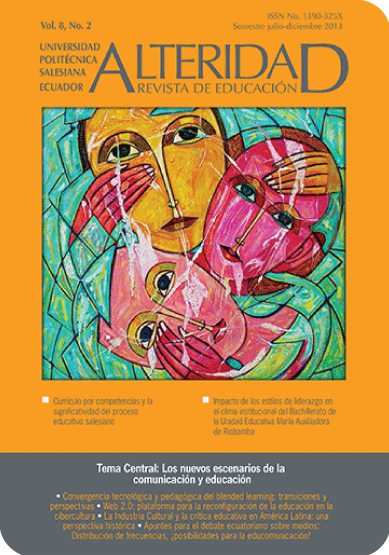The Cultural Industry and educational criticism in Latin America: A Historical Perspective
Main Article Content
Abstract
The purpose of this article is to study three authors from different academic fields who have contributed to the development of educational knowledge systems in Latin America in the areas of culture, media communication, and education. In order to do so, I will first explore a historical study about the importance of the Cultural Industry in Latin America, based on academic contributions by Andres Bello, who focused intellectually to give cohesion to national unity in the recently-established XIX century Latin American states. Enlightened culture emerges from its written and spoken language, and with support of the media at the time, the “bellista project” would become the first media communication and educational strategy aimed at capturing the new and varied dimensions of a nascent South American Culture. Similarly and in the same vein, I will look into the stance of writers and journalists, José Martí and Rubén Darío, who had to face Modernity as it began to replace the Enlightenment for a Culture for the Masses. Their poems and writings in newspapers back then, established an academic standpoint, for the first time, linked to media analysis and education, such as questioning the cultural industry and media narratives that were operating towards the end of the XIX century, in different media outlets. Finally, I examine how media analysis in Latin America emerged in the face of processes of domination that came not only from the economic but the so called cultural industries that surfaced with so much power in the mid-twentieth century. These media outlets show cultural processes as a marketable product while diluting the true real dimensions of culture.
Article Details
Section
Central Theme
Authorship: The list of authors signing must include only those people who have contributed intellectually to the development of the work. Collaboration in the collection of data is not, by itself, a sufficient criterion of authorship. "Alteridad" declines any responsibility for possible conflicts arising from the authorship of the works that are published.
Copyright: The Salesian Polytechnic University preserves the copyrights of the published articles, and favors and allows their reuse under the Creative Commons Attribution-NonCommercial-ShareAlike 3.0 Ecuador license. They may be copied, used, disseminated, transmitted and publicly displayed, provided that: i) the authorship and the original source of their publication (journal, editorial and work URL) are cited; (Ii) are not used for commercial purposes; Iii) mention the existence and specifications of this license.
Copyright: The Salesian Polytechnic University preserves the copyrights of the published articles, and favors and allows their reuse under the Creative Commons Attribution-NonCommercial-ShareAlike 3.0 Ecuador license. They may be copied, used, disseminated, transmitted and publicly displayed, provided that: i) the authorship and the original source of their publication (journal, editorial and work URL) are cited; (Ii) are not used for commercial purposes; Iii) mention the existence and specifications of this license.
References
Adorno, T. & Horkheimer, M. (2004). La industria cultural en Dialéctica de la Ilustración. Fragmentos filosóficos. Madrid: Tecnos.
Bourdieu, P. (1997). Sobre la televisión. Barcelona: Anagrama.
Brunner, J. (2003). Educación e internet ¿La próxima revolución?. Chile: Salesianos.
Cuadra A. (2012). Hiperindustria Cultural. Chile: Universidad ARCIS.
Eco, H. (1995). Apocalípticos e integrados. Barcelona: Tusquets Editores.
Eddine A. & Mohammed N. (2000). La interculturalidad de Nc World en el paradigma globalitario.
Geertz, C. (1987). La interpretación de las culturas. México: GEDISA.
Lipovetsky, G. (2006). Los tiempos hipermodernos. Barcelona: Anagrama.
Mattelart, A. (1995). La invención de la comunicación. México: Siglo XXI.
(1998). Pensar sobre los medios. Comunicación y crítica social. Buenos Aires: Paidós.
Ortiz, R. (1998). Los artífices de una cultura mundializada. Bogotá: Siglo del Hombre.
Ossandón, C. (2013). Industrial cultural y espacio público en América Latina. Universidad ARCIS.
Languella, Robert. (2011). “Para leer al Pato Donal”. Consultada el 7 de febrero de 2014. Disponible en: http://robertolangella.blogspot.com/2011/11/para-leer-al-pato-donaldde-dorfman-y.html.
Bourdieu, P. (1997). Sobre la televisión. Barcelona: Anagrama.
Brunner, J. (2003). Educación e internet ¿La próxima revolución?. Chile: Salesianos.
Cuadra A. (2012). Hiperindustria Cultural. Chile: Universidad ARCIS.
Eco, H. (1995). Apocalípticos e integrados. Barcelona: Tusquets Editores.
Eddine A. & Mohammed N. (2000). La interculturalidad de Nc World en el paradigma globalitario.
Geertz, C. (1987). La interpretación de las culturas. México: GEDISA.
Lipovetsky, G. (2006). Los tiempos hipermodernos. Barcelona: Anagrama.
Mattelart, A. (1995). La invención de la comunicación. México: Siglo XXI.
(1998). Pensar sobre los medios. Comunicación y crítica social. Buenos Aires: Paidós.
Ortiz, R. (1998). Los artífices de una cultura mundializada. Bogotá: Siglo del Hombre.
Ossandón, C. (2013). Industrial cultural y espacio público en América Latina. Universidad ARCIS.
Languella, Robert. (2011). “Para leer al Pato Donal”. Consultada el 7 de febrero de 2014. Disponible en: http://robertolangella.blogspot.com/2011/11/para-leer-al-pato-donaldde-dorfman-y.html.

